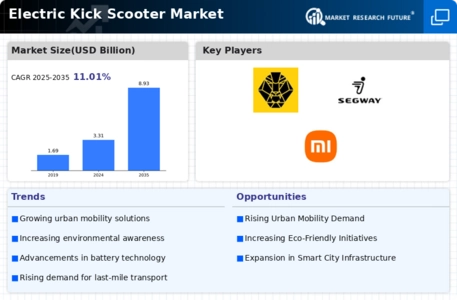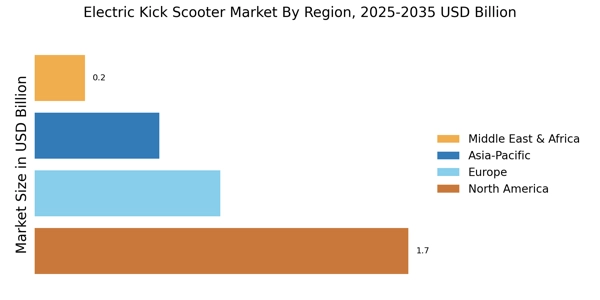Environmental Awareness
Growing environmental awareness is a key driver for the Electric Kick Scooter Market. As concerns about climate change and air pollution intensify, consumers are increasingly seeking eco-friendly transportation alternatives. Electric kick scooters produce zero emissions during operation, making them an attractive option for environmentally conscious individuals. In recent years, the market has seen a notable increase in sales, with estimates suggesting that electric scooters could reduce urban carbon footprints by up to 30%. This shift towards sustainable transportation is not only beneficial for the environment but also aligns with governmental initiatives aimed at promoting green mobility solutions. Consequently, the Electric Kick Scooter Market is likely to benefit from this heightened focus on sustainability.
Rising Urban Population
The rising urban population is a significant driver of the Electric Kick Scooter Market. As more individuals migrate to urban areas, the demand for efficient and convenient transportation options increases. Urban centers are often characterized by limited parking and heavy traffic, making electric kick scooters an attractive solution for short-distance travel. Projections indicate that by 2025, urban populations will continue to grow, further fueling the need for micro-mobility solutions. This demographic shift is likely to lead to an expansion of electric scooter rental services, catering to the needs of urban dwellers. The Electric Kick Scooter Market is thus well-positioned to capitalize on this trend, providing a practical alternative for navigating densely populated areas.
Urban Mobility Solutions
The Electric Kick Scooter Market is experiencing a surge in demand due to the increasing need for efficient urban mobility solutions. As cities become more congested, traditional transportation methods are often inadequate. Electric kick scooters offer a convenient alternative, allowing users to navigate through traffic with ease. In 2025, the market is projected to grow at a compound annual growth rate of approximately 8.5%, driven by urban populations seeking flexible transportation options. This trend is further supported by the rise of micro-mobility services, which integrate electric scooters into public transport systems, enhancing accessibility and reducing reliance on cars. The Electric Kick Scooter Market is thus positioned to play a pivotal role in reshaping urban transportation dynamics.
Technological Advancements
Technological advancements are significantly influencing the Electric Kick Scooter Market. Innovations in battery technology, such as lithium-ion batteries, have enhanced the performance and range of electric scooters, making them more appealing to consumers. Additionally, the integration of smart technologies, including GPS tracking and mobile app connectivity, has improved user experience and safety. As of 2025, the market is expected to witness a rise in demand for scooters equipped with advanced features, such as anti-theft systems and automated speed control. These developments not only enhance the functionality of electric scooters but also contribute to their growing popularity among urban commuters. The Electric Kick Scooter Market is thus poised for continued growth as technology continues to evolve.
Government Initiatives and Regulations
Government initiatives and regulations play a crucial role in shaping the Electric Kick Scooter Market. Many governments are implementing policies that encourage the use of electric scooters as part of broader efforts to reduce traffic congestion and promote sustainable transportation. Incentives such as subsidies for electric vehicle purchases and the establishment of dedicated scooter lanes are becoming more common. In 2025, it is anticipated that regulatory frameworks will continue to evolve, providing clearer guidelines for scooter usage and safety standards. This supportive environment is likely to foster growth in the Electric Kick Scooter Market, as consumers feel more confident in adopting this mode of transport.


















Leave a Comment